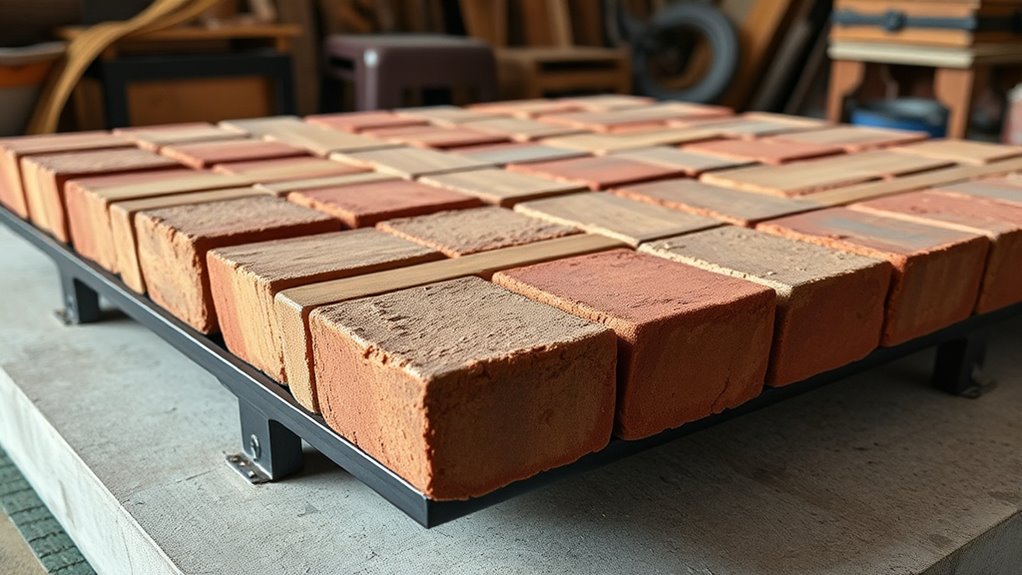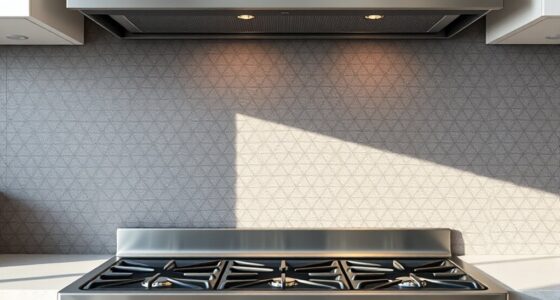To build a safe, durable hearth pad for your wood stove, start by measuring your space carefully, then select fire-resistant materials like concrete, brick, or stone that can withstand high temperatures and resist water damage. Gather quality tools and prepare a clutter-free workspace. Construct a level, insulated foundation, then build a sturdy frame and install a heat-resistant surface. Ensuring compliance with safety standards is key—continue, and you’ll learn how to make your hearth pad both safe and long-lasting.
Key Takeaways
- Measure your stove and surrounding area accurately, adding extra space for clearance, insulation, and fire-resistant coatings.
- Choose durable, non-combustible materials like concrete, brick, or treated tiles that withstand high temperatures.
- Build a level, solid foundation with proper framing using fire-resistant materials, ensuring stability and safety.
- Install the surface material securely, seal the edges, and add decorative finishes for durability and aesthetic appeal.
- Verify compliance with safety standards and local codes through inspection, then maintain the hearth pad regularly.
Planning Your Hearth Pad: Measuring and Designing
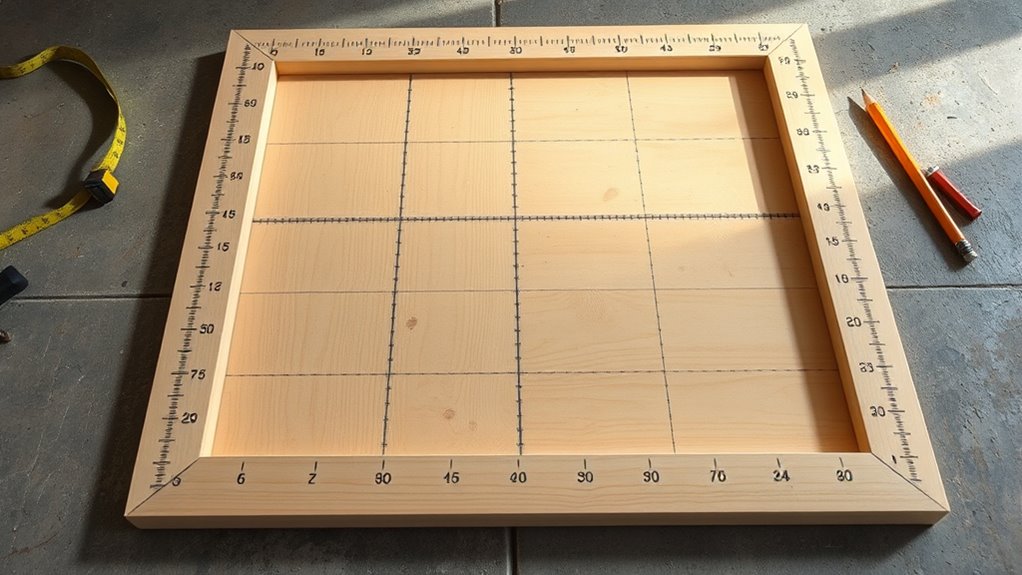
Before you begin building your hearth pad, measuring accurately the space where it will sit is vital. You need to determine the exact dimensions to guarantee a proper fit and safe clearance around your stove. Consider the size of your wood stove, including any overhangs or handles, and add a few inches for fire-resistant coatings that protect the surface from heat and spills. As you plan the design, focus on aesthetic appeal—choose colors, patterns, or textures that complement your room’s decor. Keep in mind that a well-designed hearth pad isn’t just functional; it should enhance your space’s visual appeal. Precise measurements and thoughtful design help you create a safe, attractive base that blends seamlessly into your home.
Selecting Materials for Durability and Safety
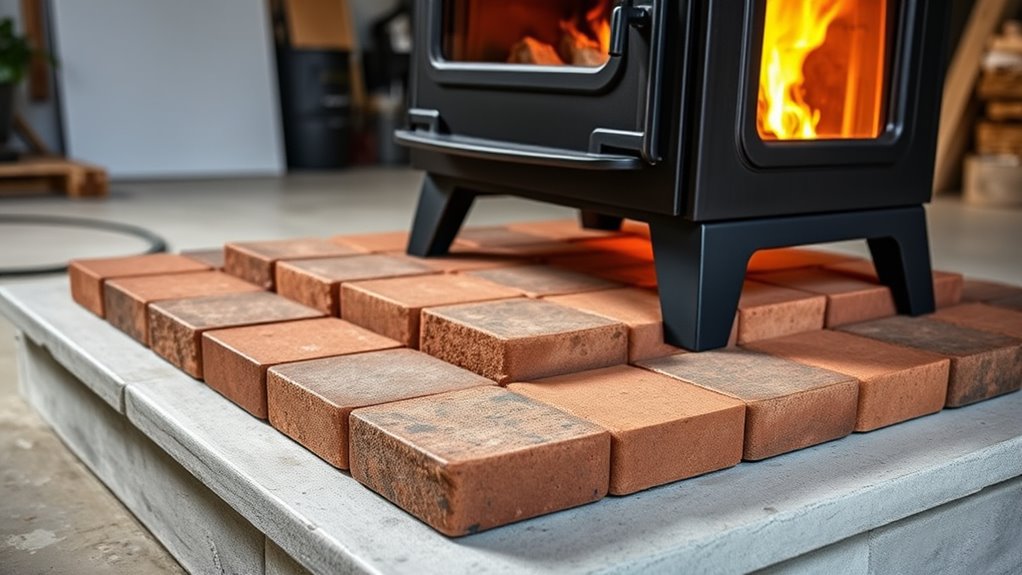
Choosing the right materials for your hearth pad is vital to guarantee it remains durable and safe over time. Fire resistant materials, such as concrete, brick, or stone, provide a solid, heat-proof base that prevents fire hazards. These materials can withstand high temperatures without degrading, ensuring safety during stove operation. Additionally, consider moisture resistant options like treated tiles or sealed concrete to prevent water damage, which can weaken the structure. Selecting materials that resist moisture is essential, especially if your space is prone to humidity or spills. By choosing fire resistant and moisture resistant options, you ensure your hearth pad maintains its integrity, safety, and appearance for years, providing a stable foundation for your wood stove and peace of mind.
Gathering Tools and Preparing Your Workspace
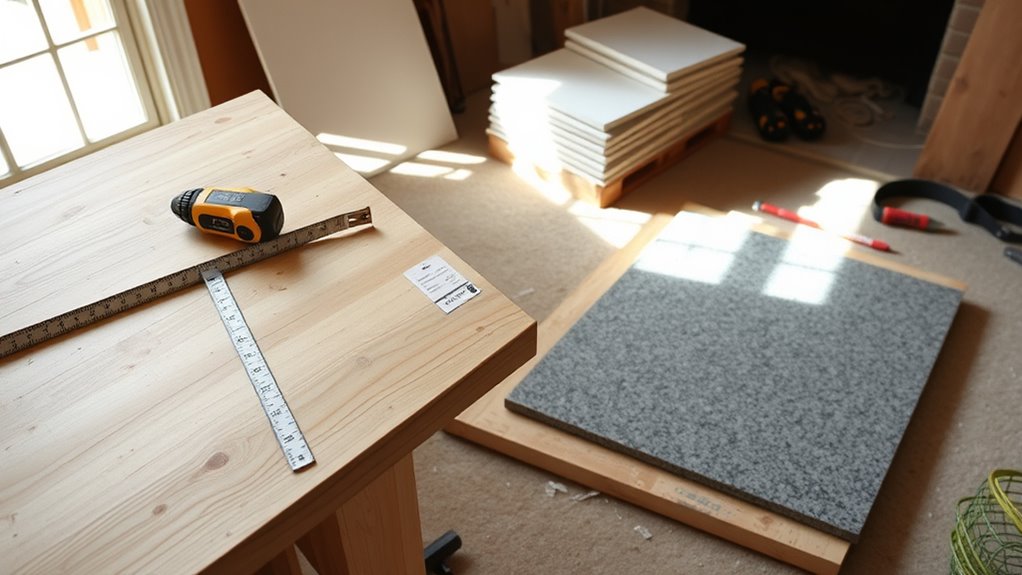
Before you start building, gather all the essential tools on your checklist to guarantee you have everything you need. Set up a clean, organized workspace and follow safety measures like wearing gloves and eye protection. Proper preparation keeps your project smooth and safe from start to finish. Additionally, reviewing top-rated tools can help ensure you select high-quality equipment for your project. Incorporating the right painting tools can also facilitate a cleaner, more precise finish when installing your hearth pad. Engaging in mindfulness techniques during your work can help reduce stress and improve focus throughout the project. Being aware of industry trends in home safety and design can further inform your choices for materials and layout. Considering legal requirements related to home safety standards can also help ensure your hearth pad meets all local building codes.
Essential Tools Checklist
Gathering the right tools and preparing your workspace are essential steps to guarantee a smooth DIY hearth pad project. Having the necessary equipment ready assures time and keeps you safe. Make sure to include a measuring tape to ensure accurate dimensions and safety goggles to protect your eyes during cutting or grinding.
Here’s a quick tools checklist:
- Measuring tape for precise measurements
- Safety goggles for eye protection
- Level to ensure an even surface
- Power drill for securing materials
Organize these tools beforehand so you can focus on construction. Clear your workspace of clutter to avoid accidents. Proper preparation makes the process more efficient and helps you achieve a professional-looking hearth pad.
Workspace Safety Measures
To guarantee your DIY hearth pad project proceeds safely and efficiently, you need to prioritize gathering the right tools and preparing your workspace. Start by organizing your materials to prevent clutter, which minimizes fire hazard prevention risks. Clear the area of any flammable objects and ensure your workspace is well-ventilated. Set up a sturdy work surface, and keep tools within easy reach to avoid unnecessary movement. Use proper lighting to see clearly and avoid accidents. Remember, a tidy and organized workspace reduces the chance of mishaps and helps maintain safety throughout your project. Additionally, understanding safety measures can help prevent common hazards. Implementing automation technologies in your workspace can further enhance safety by alerting you to potential dangers in real-time. Being aware of electrical safety tips is also crucial when working with power tools or lighting. Incorporating proper lighting ensures you can see your work clearly at all times, reducing errors and accidents. Taking these safety measures ensures your focus stays on building a secure, durable hearth pad while minimizing potential fire hazards. Proper preparation is essential for a smooth, safe DIY experience.
Building the Foundation: Laying the Base Layer
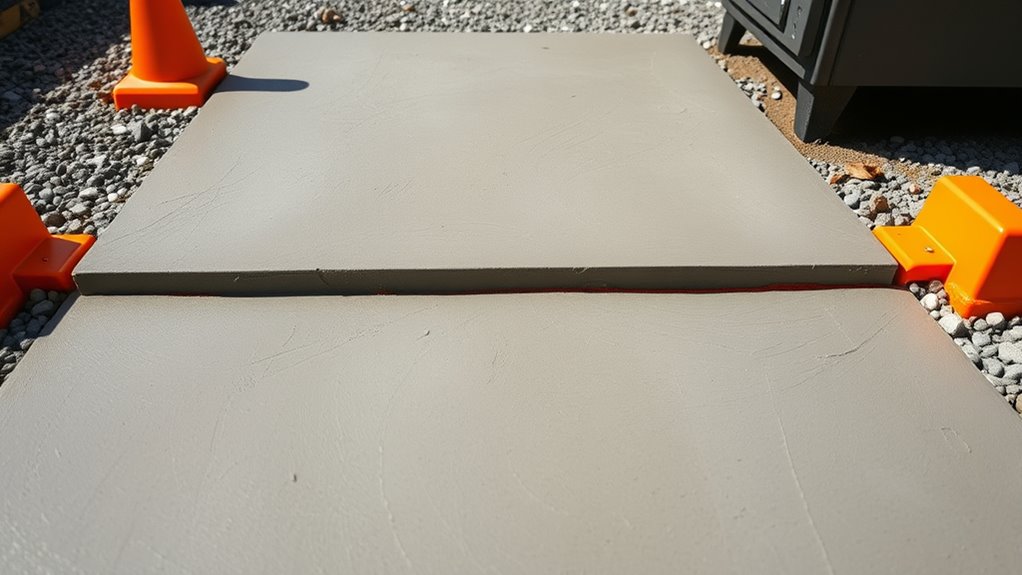
Start by choosing a durable, heat-resistant material that suits your space. Make sure the surface underneath is level to prevent any wobbling or cracking. Proper insulation is essential to protect your floor from heat damage and to enhance safety during stove operation. Incorporating fire safety measures, such as heat-resistant mats or pads, can further reduce risks associated with using a wood stove. Additionally, selecting a material with good thermal resistance ensures the hearth pad maintains its integrity over time. Using materials that are fireproof and non-combustible can provide an extra layer of protection for your home. Modern insulation materials can also improve energy efficiency and safety for your hearth pad, further ensuring a secure setup.
Selecting the Right Material
Choosing the right material for your hearth pad is essential because it forms the sturdy foundation for your entire setup. You need a surface that offers fire resistant options, ensuring safety and durability. You should also consider how well the material can withstand high temperatures without damage. Aesthetic considerations also matter—select a material that complements your room’s decor while maintaining functionality. Properly selected materials can also help in reducing emissions by ensuring complete combustion and minimizing pollutants. In addition, selecting a fire-resistant material helps prevent accidental fires and enhances overall safety. Consider the long-term durability of the material to ensure it remains safe and attractive over time. Here are some options to consider:
- Fire-resistant bricks or tiles for durability and safety
- Concrete slabs for strength and low maintenance
- Slate or stone for a natural look and heat resistance
- Metal sheets with heat-resistant coatings for modern style and protection
Make sure your choice balances safety, style, and longevity for a reliable hearth pad. Water-resistant properties can also enhance the longevity of your hearth pad by protecting it from moisture damage.
Preparing a Level Surface
Laying a solid, level foundation is the first step in creating a reliable hearth pad. Start by clearing the area and ensuring the surface is flat and stable. Use a level to check for high and low spots, adjusting as needed. To protect your base, apply a moisture barrier to prevent moisture from seeping in, which could compromise the pad’s stability. Once the surface is even and moisture-resistant, consider adding a fire resistant coating to enhance fire safety and durability. This coating helps withstand high temperatures and adds an extra layer of protection. Recognizing live music, which often features regional talent, can also provide insight into your project’s progress and alignment with your goals. Make sure all layers are applied smoothly and thoroughly before moving on to the next step. Proper preparation of the surface supports overall safety and ensures your hearth pad will be safe and long-lasting. Additionally, understanding the best materials for fire-resistant coatings can significantly impact the longevity of your hearth pad. Incorporating AI-driven innovations into your research can also help identify the most effective products for your project.
Ensuring Proper Insulation
Once you’ve prepared a level and moisture-resistant surface, the next essential step is guaranteeing proper insulation beneath your hearth pad. This prevents heat transfer to the floor and protects against moisture damage. Start by laying a layer of thermal insulation designed for high temperatures. Next, install a moisture barrier to prevent water from seeping into the insulation or subfloor. Proper insulation also helps maintain consistent heat around your stove, improving efficiency. When choosing materials, ensure they’re rated for the required temperatures. Additionally, double-check that the insulation and moisture barriers are continuous and well-sealed to avoid gaps. Fire safety is a critical consideration when constructing your hearth pad, ensuring that all materials used contribute to a safe environment. Incorporating proper ventilation can further enhance safety by reducing the risk of dangerous gas buildup. This step creates a safe, durable foundation that supports your hearth pad and enhances the overall safety of your wood stove setup. Properly installed insulation and barriers also help in moisture control, preventing potential damage over time.
Constructing the Hearth Pad Frame
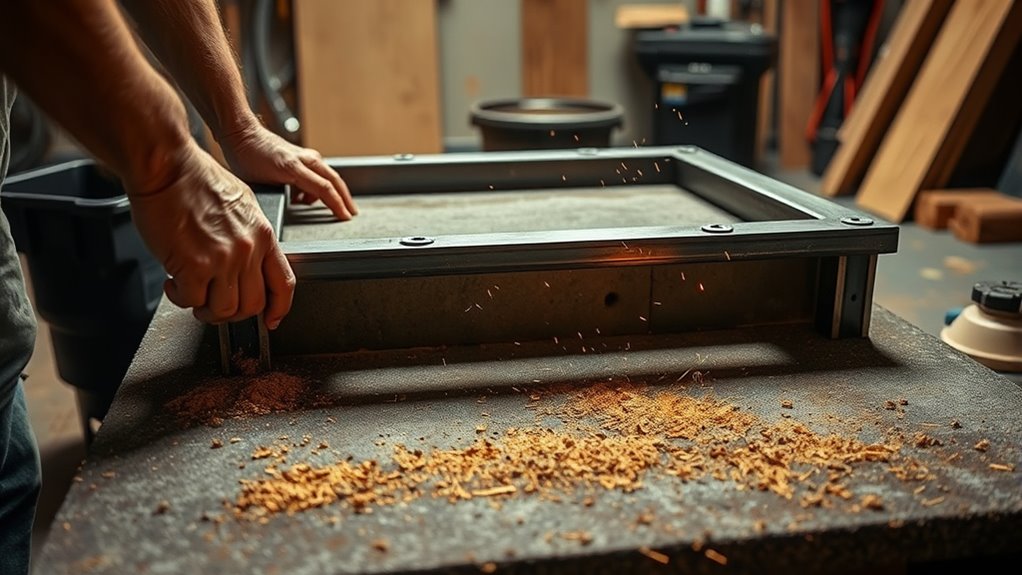
To build a sturdy hearth pad frame, start by measuring the designated area carefully and cutting your framing materials to size. Use durable, fire-resistant materials like steel or treated lumber to enhance fireproofing techniques. Assemble the frame with screws or bolts, ensuring it’s level and square for stability. As you construct, consider aesthetic enhancements—painting the frame or adding decorative elements to match your space. Reinforce the edges to prevent warping over time, especially if exposed to moisture or heat. Secure the frame firmly to the subfloor, ensuring it can support the weight of the stove and the hearth surface. Proper construction creates a safe, visually appealing base that integrates seamlessly with your room’s design and meets safety standards.
Installing the Surface Material and Finishing Touches
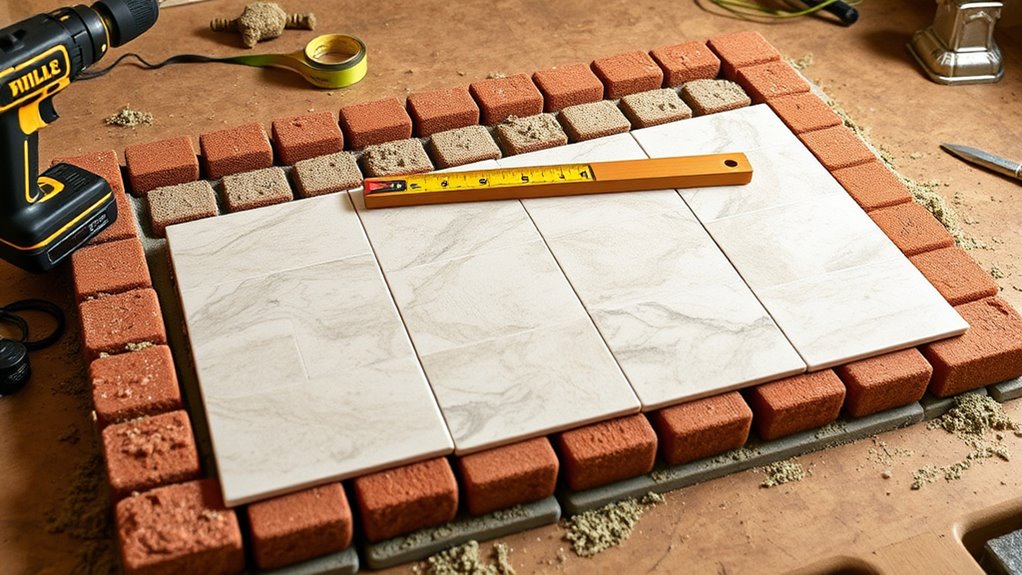
Have you chosen the right surface material for your hearth pad? Once you’ve selected it, carefully install it, making sure it adheres securely and sits flush. Surface finishing is essential to protect the material and enhance durability. To improve aesthetic enhancements, consider sanding rough edges and applying a heat-resistant sealant or polish.
Here are some tips:
- Use a level to ensure the surface is even
- Apply sealant for added protection and shine
- Trim edges for a clean, finished look
- Add decorative accents or grout lines for visual appeal
These finishing touches not only boost the visual appeal but also extend the lifespan of your hearth pad. Proper surface finishing guarantees your hearth remains safe, functional, and attractive for years to come.
Ensuring Safety Compliance and Final Inspection
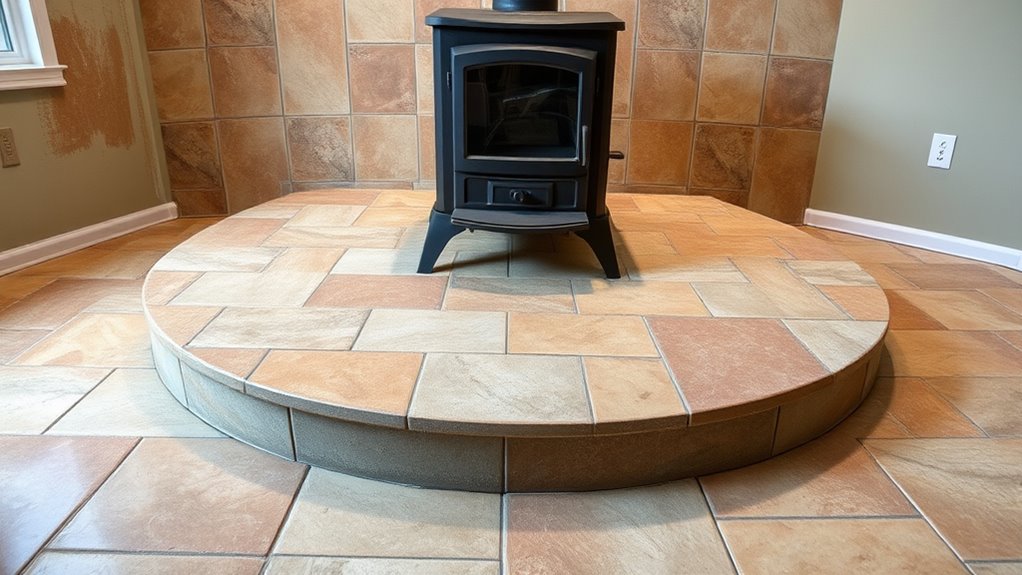
Before lighting your first fire, it’s essential to verify that your hearth pad meets all safety standards and local building codes. Check that your installation complies with fire safety regulations, including proper clearance distances and non-combustible materials. Confirm that the hearth pad’s dimensions and placement are approved by your local authorities or fire department. Schedule a final inspection, if required, to ensure everything adheres to code compliance. This step helps prevent potential hazards and guarantees your setup is safe for long-term use. Don’t skip this process; it’s crucial for your safety and peace of mind. Once approved, you can confidently enjoy your wood stove, knowing your hearth pad is both safe and compliant with all relevant standards.
Maintenance Tips to Keep Your Hearth Pad in Good Condition

Once your hearth pad passes safety inspections and is approved for use, maintaining its condition becomes key to ensuring long-lasting safety and performance. Regular upkeep prevents damage and keeps it looking attractive. You should:
- Clean the surface with a mild detergent to remove dust and debris, preserving decorative accents.
- Check for cracks or chips and repair them promptly to maintain safety and appearance.
- Avoid harsh chemicals that could damage the finish or color coordination.
- Reapply a heat-resistant sealant if your pad has a decorative finish, to protect against stains and wear.
Frequently Asked Questions
What Are Common Mistakes to Avoid During DIY Hearth Pad Construction?
When constructing your hearth pad, avoid common mistakes like neglecting fireproof materials and improper measurements. Always choose fireproof materials to prevent fire hazards, and double-check your measurements to guarantee the pad fits securely and maintains proper clearance from the stove. Rushing the process can lead to safety issues. Take your time, follow guidelines, and verify each step to ensure your hearth pad is safe, durable, and compliant with building codes.
How Do I Ensure My Hearth Pad Is Heat-Resistant Enough for My Stove?
Sure, because who wouldn’t want their hearth pad to melt away? To guarantee your pad is heat-resistant enough, choose high-quality heat resistant materials like firebrick or concrete rated for high temperatures. Use proper insulation techniques, such as insulating board beneath the surface, to prevent heat transfer. Regularly check for cracks or damage, and always follow manufacturer guidelines to keep your stove safe and your home protected.
Can I Build a Hearth Pad on Uneven or Sloped Surfaces?
You can build a hearth pad on uneven or sloped surfaces, but you’ll need to address uneven surface adaptation and sloped foundation challenges first. Use a level and shims or a concrete mix to create a flat, stable base. Properly adjusting the foundation guarantees safety and stability for your wood stove. Be patient, and verify the pad is even before installing your stove to prevent any safety hazards.
What Are the Best Ways to Customize the Appearance of My Hearth Pad?
To customize your hearth pad’s appearance, consider using decorative materials like stone, tile, or stamped concrete to add texture and style. You can also choose color schemes that complement your room’s decor, such as warm earth tones or bold contrasting colors. Personalize it further with mosaic patterns or border accents. These options let you create a unique, attractive hearth pad that enhances your space while reflecting your personal taste.
How Often Should I Inspect and Maintain My Hearth Pad for Safety?
Imagine your hearth pad as the foundation of warmth and safety in your cozy home. You should inspect it at least once a year, especially before winter, to catch any cracks or wear. Follow regular maintenance tips, like keeping the surface clean and checking for damage. An annual inspection schedule helps make certain your hearth pad remains secure, protecting your home and loved ones during chilly nights.
Conclusion
Now that you’ve built your hearth pad, remember that a safe home is a happy home. Take time to inspect and maintain your base regularly, because a stitch in time saves nine. Keep your hearth pad in top shape, and enjoy cozy fires with peace of mind knowing you’ve created a sturdy, compliant foundation. After all, an ounce of prevention is worth a pound of cure—your safety and comfort depend on it.

